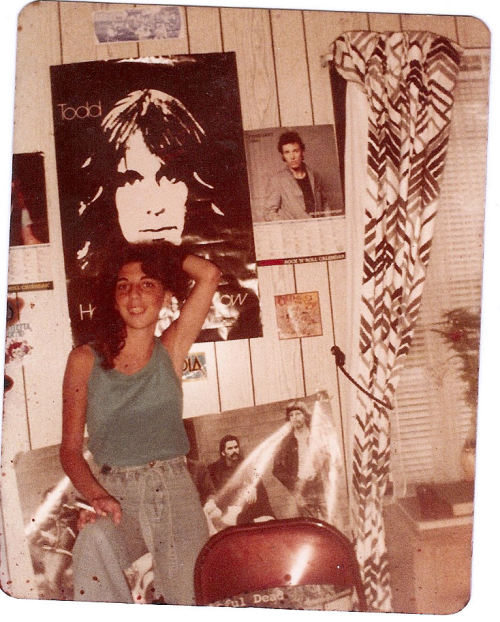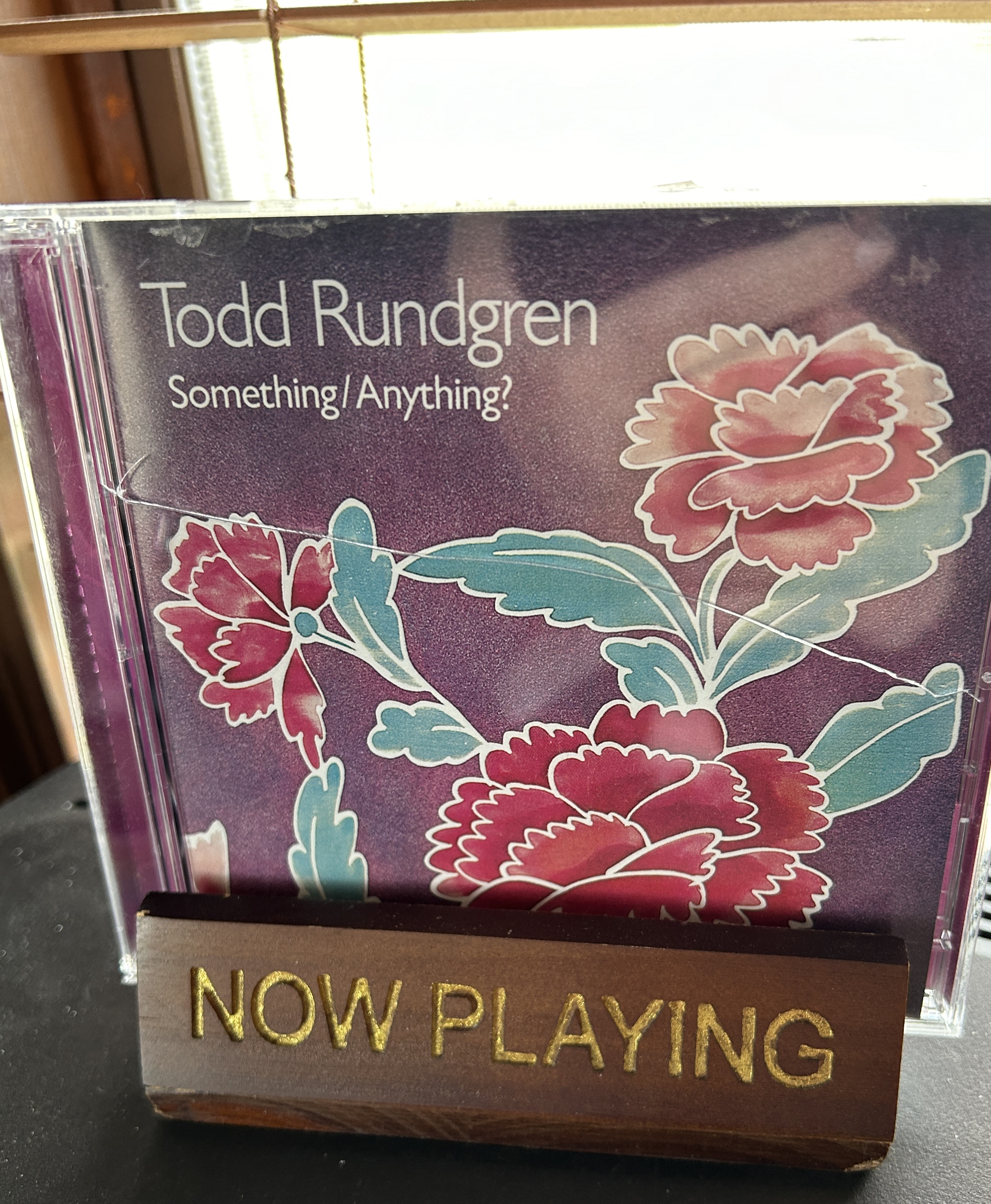
The Beastie Boys and Me
Published on Dec 10, 2025
The Doors and Me
Published on Dec 8, 2025
Hold the Line: a breakup story starring Toto
Published on Dec 3, 2025
Letter From the Publisher
Published on Nov 29, 2025
More Liner Notes…
Hello, It's Me: My Intro to Todd Rundgren
by editor Michele Catalano

The first time I consciously heard “Hello It’s Me” was in 1975. I’m sure I’d heard it before; it came out in 1972, when I was ten. Chances are I heard it on the radio, either the staticky AM station my mom listened to, or one of the FM stations I spun the dial to on the living room stereo. It just didn’t register with me until I was 13, a teenager in every expanded sense of the word—surly, emotional, indifferent, and all those other things teenagers can be.
After school, we often went to Enid’s house to listen to music and gossip. Her parents were never home, and we had the run of the house. Enid was a year older but had the name and demeanor of someone ancient, like my parents’ age. She took care of everyone, comforted us when we were in a fight with our parents, helped us with our homework, and provided snacks when we were there.
I liked Enid but in some ways was intimidated by her. She seemed to have it all together, unlike me. I was anxious, awkward, and shy. That I was hanging out with the cool kids at all was a matter of circumstance. We all lived on the same block, and I fell in with them by default.
I lived on the periphery of that group, choosing to remain quiet and let the older kids speak. I just listened and learned their lingo, their behavior. I kept up with them when they stole beer and cigarettes from Lori’s father, even though being tipsy at first left me feeling weird. I didn’t mind being on the edge of the group. I was happy not to draw any attention to myself.
It was one of those fall days when you feel winter creeping around the corners. There was a little bite to the wind, and I was happy to finally get inside Enid’s house after walking home from school. Enid brought out chips and soda. and we sat on various couches and pillows—there were about eight of us—and waited for Enid to set the tone for the afternoon. She tuned the stereo to 99X. No AM static, a sound I had grown to love because it reminded me of home. Instead it was the smooth, clear sound of the top hits of the day, mostly songs that would be referred to now as Yacht Rock.
That particular day, Enid lit candles and turned off the lights. She wanted us to meditate while we were listening to the music. So we lay there in the dark, 99X playing maybe “Born to Run” or “Wish You Were Here,” I really don’t remember. I just remember what happened next, when the first notes of “Hello It’s Me” dropped and Todd Rundgren started singing.
Hello, it’s me I’ve thought about us for a long long time Maybe I think too much but something’s wrong There’s something here, doesn’t last too long Maybe I shouldn’t think of you as mine
My heart felt funny, as if someone was squeezing it. I felt something else, lying there on the couch with my eyes closed, but I could not name it. I wondered, as the song progressed, if this was what heartbreak felt like. I heard the hurt in his voice, the resigned sadness.
I was thirteen. I didn’t know anything about romantic love. I’d never even had a crush on a boy. Yet here I was, feeling as if someone had emotionally crushed me.
Lori whispered from the love seat, “Who is this?” Enid, who knew everything, told us it was Todd Rundgren. I did not know it then, but I had just learned the name of the man who would occupy a large space in my head well into the ‘90s.

It’s important to me That you know you are free ‘Cause I never want to make you change for me
I think the word, the feeling I had been looking for was poignant. The lyrics felt so pointed and sincere that they gutted me. It was the first time I had any inkling that loving someone could break your heart. I would learn, in later years, that giving love meant opening yourself up to hurt, but to get a taste of that at 13—the most emotionally volatile age for a young girl—left me devastated.
By the time I felt the tears streaming down my face, the candles were out, the lights were on, and Foghat’s “Slow Ride” was playing. I hid my face in the pillow and pretended I fell asleep so no one could see that I had been crying. I was already labeled the “sensitive” one; I didn’t want to give anyone further reason to mock me. But Enid knew. I don’t know if she could read the vibes in the room, or if she somehow saw me crying; but she came over, sat next to me, and handed me a cookie.
“Pretty good song,” she said.
“It made me have a lot of feelings.”
“That’s Todd Rundgren for you,” she said, and laughed.
Enid never made me feel that I was a hanger-on. She treated me like I needed TLC, and, in many ways, I did. That she was so in tune to my feelings, and so often went out of her way to make me feel welcome and included, was my first experience with kindness from my peers. I had been bullied and mocked throughout elementary school. Enid took me under her wing, protected me, and nurtured me. She paved the way for me to feel confident going into ninth grade, when I switched to a Catholic high school where I knew no one.
As for Todd Rundgren, I didn’t rush home and ask my mother to buy me the record. I thought about it for days, and called 99X every day to request it. Every once in a while, they’d get around to playing it. Instead of crying, I’d remember Enid being kind to me and feel warmth. “Hello It’s Me” became a touchstone of sorts. It separated my old self from my new self. I went into Enid’s house that day as a naive 13-year-old and left with a newfound sense of what it’s like to give of yourself, thanks to both Enid’s and Todd Rundgren’s words.
When I started the new school the next year, I met some people who were really into Todd Rundgren and latched onto them. I grew into being a real fan: buying his records and cassettes, reading liner notes and articles about him, studying his lyrics. I went to see him at the Capitol Theater in New Jersey, and then at Hofstra University for a Q&A session. And I stopped crying during “Hello, It’s Me,” not knowing that, almost fifty years later, it would be “Can We Still Be Friends” that would make me cry.
Enid moved the next year. I stopped hanging out with that group of friends, having moved on to the friends I was making in high school. Enid set the benchmark for what I wanted in that respect. I sought out people who were kind and empathetic and who would let me into their circle without judging. That they were all fans of Todd Rundgren was a bonus.
I still listen to Todd. I recently bought myself a copy of Something/Anything and spent some time with it. I thought about Enid, about that day in her living room, about friendships and love. I might have cried.
I Have That on Vinyl is a reader supported publication. If you enjoy what’s here please consider donating to the site’s writer fund: venmo // paypal. Tips go toward paying writers, an editor and for site maintenance

